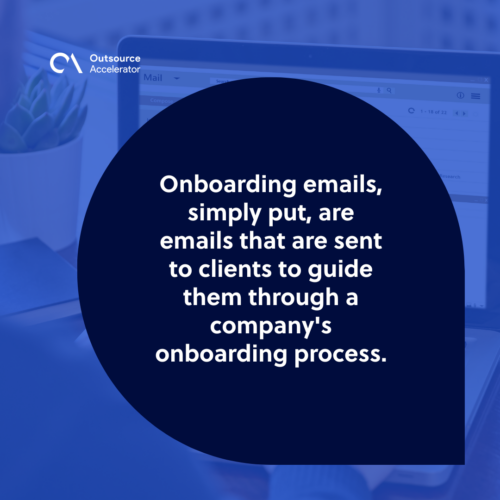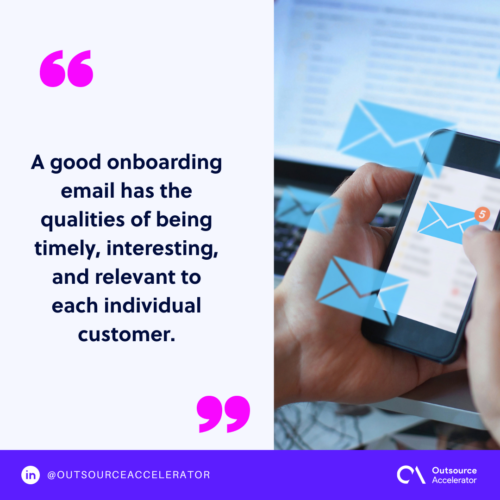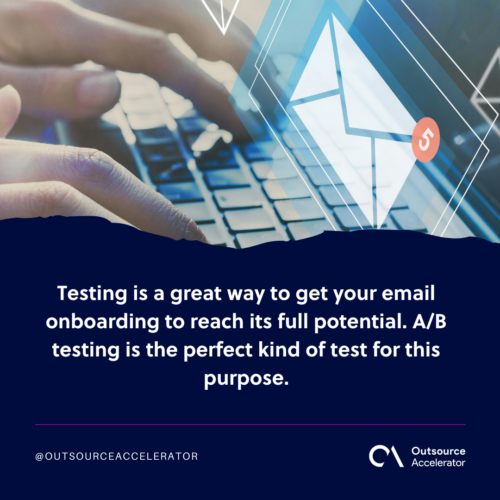Onboarding emails: Top examples and best practices

A company’s customer onboarding process is an important facet of the customer experience (CX). Involved in this process are all activities that are planned and accomplished with the goal of introducing new customers to the company’s product or service.
The onboarding process is all abouteducating your new clients about the value that they can get from the product or service that they availed.
Additionally, it is an opportunity to demonstrate to clients that your company is the kind that will make their lives more convenient for the long-term.
An important aspect of the customer onboarding process is crafting onboarding messages and sending them to new customers.
This is where onboarding emails come in.
This article delves into onboarding emails and its many types, why your company needs them, and the best practices you need to keep in mind when composing them.
What are onboarding emails?
Onboarding emails, simply put, are emails that are sent to clients to guide them through a company’s onboarding process.
They are sent directly to customers after they sign up for a company’s product or service.
Besides welcoming new clients, onboarding emails can also serve different purposes depending on the customer’s journey.
They may demonstrate how to use products or services, encourage interaction, upsell other offers, and answer questions, among others.

Why you need onboarding emails
A company’s customer onboarding process is a crucial aspect of the customer experience.
Onboarding emails, in turn, are a key component of any onboarding process. This means that optimizing them is a huge responsibility of any business.
Email onboarding, when implemented correctly, will greatly help your company. Use emails to inform clients of the benefits that your company’s products and services can offer them.
These emails can be the reason for your new customers to become long-term supporters.
On top of that, email onboarding can help you convert visitors to paying customers, keep existing clients engaged, and reignite engagements with inactive customers.
Onboarding email examples: How to write onboarding emails for clients
Writing onboarding emails requires the quality of being crafty. These emails need to be appealing to the customers and, simultaneously achieve the goal you had in mind.
A good onboarding email has the qualities of being timely, interesting, and relevant to each individual customer.
The next section contains some types of onboarding emails. There will be an accompanying example for each type, and you can use them as a guide in creating your own.
Types of onboarding emails (with template examples)
1. Welcome emails
When customers sign up for a product or service, they expect a welcome email. A welcome email is your chance to make a good first impression.
An effective welcome email paves the way for a meaningful and long-term relationship with a customer. It shouldn’t come off as too salesy or else it may repel customers – which is the opposite of what you want for your business.
Use welcome emails to guide new customers so that they are informed of the next steps they can take. Make them fun, engaging, and pleasing to the eyes.
Here is a template you can use for welcome emails:
Subject: Welcome to [company/product name]!
“Hello, [customer name]!
Welcome to [company/product name].
I am [your name] from [your company name].
We are so glad to have you onboard. Thank you for joining the [company name] community by signing up for [product/service]!
If you have any questions about [product/service], feel free to reply to this email directly. I am here for any concern of yours.
Looking forward to providing you with a great experience!
Sincerely,
[Your name]”
2. Cross-selling and upselling emails
A customer who already shows interest in one of your products is more likely to buy your other products. It can be a good idea to advertise to this type of customer.
You can do this by sending cross-selling and upselling emails. They are written exclusively to sell products or services, ideally something that goes perfectly with the product that was already purchased by the customer.
Here’s an example template you can use for this:
Subject: Try our new [product/service]
“Hello, [customer name]!
We have released a new product/service called [product/service name]!
It is a [type of product/service] that you can use for [purpose]. It includes features such as [list of best features].
With [product/service name], you will be able to [benefits]!
If you are interested, you can check it out here: [link]
Try it for free for [free trial duration]!
Leave a review here: [link] so we know how to improve [product/service name] for you.
With thanks,
The [ your company/product name] Team”
3. How-to emails
It is inevitable for companies to get customers who buy their products but have no idea how to use them. This is what demonstration emails are for.
How-to emails contain instructions on how to use a company’s product or service, some of them with an accompanying demonstration video. They are also a perfect chance to show off your product’s features.
The sooner your customers learn how to best make use of your offers, the better. Because otherwise, they might just give up engaging with your company altogether.
Below is an example of a how-to email:
Subject: How to [activity/goal] with [product/service]
“Hey there, [customer name]!
Thank you for purchasing [product/service]!
Maximize your time using it with these features: [features list]!
[Insert short and clear instructions on how to use each feature, preferably using bullet points or a checklist format.]
Here is a video demonstration of [product/service] and its features in action: [link]
We hope this helps!
Thanks again,
The [your company/product name] Team”
4. Offer emails
This type of email contains an offer with the goal of seducing a customer so much so that they would have to engage with your brand.
Offers may be in the form of discounts, coupons, free trials, etc.
Offer emails can build customer loyalty. By giving your clients incentives, you are encouraging them to support your company further.
Here is an offer email template:
Subject: Last chance to get [offer]!
“Hello, [customer name]! We hope you’re doing well.
We are offering [offer] for a limited amount of time.
Get it now before it’s gone! There’s only [time left] left on this offer.
You can check it out here: [link]
Don’t miss this opportunity!
Sincerely,
The [your company/product name] Team”
5. Customer support emails
You will know from previous experience the most common problems that customers experience with your products.
Use customer support emails to address frequently asked questions and answer them for a new customer who hasn’t even thought of them yet.
Proactive customer support will improve your customer’s opinion of your company.
Subject: FAQs about [product/service]
“Hey, [customer name]!
[Your name] of [your company name] here.
You might be wondering, “How do I use [product/service]?” “What is the [specific feature] feature for?”
Well, there is no need to fret. We’ve compiled the most frequently asked questions about [product/service] along with our answers to them.
Frequently Asked Questions about [Product/Service]
[Insert list/compilation of FAQs with answers. It is best to categorize them so that your customer won’t have a hard time navigating]
If you have a question that wasn’t addressed here, you can ask me directly. I am always available to answer your queries.
Hope this helps. Good luck and thanks again!
Sincerely,
[Your name]”

6 Best practices for effective onboarding emails
When crafting onboarding emails, no matter which type or for whatever purpose, there are some practices that you need to keep in mind.
These will help ensure that your emails are the best that they can be, both for you and your clients.
Some of the best practices for effective email onboarding include:
1. Personalization
Onboarding emails are a chance for your company to make a good first impression and maintain it.
An effective way of making emails more engaging for your customers is by personalizing them.
When companies use a non-personalized email, it makes the interaction feel forced and robotic. And more often than not, customers notice and disapprove of the lack of personal touch.
The most commonly used information for personalization are customers’ first names. However, you can derail from the generic templates by collecting more information about your customers and finding a way to insert them into your emails in a way that sounds natural.
2. Content should have a CTA
Onboarding emails have a call-to-action. Each is written for the purpose of making a customer (further) support them in some way.
Depending on the type of onboarding email you are going to compose, plan the CTA that you would like to include.
Work around that CTA. Write the body of your email with it in mind. Every sentence in your email’s body should meaningfully contribute to it.
3. Maintain simplicity
There is zero reason for onboarding emails to be lengthy and complicated. Sometimes, less is more.
Customers, especially new ones, are less likely to read long emails. You will need to keep your emails short and simple while still making sure that they contain all the necessary information.
Remember not to shy away from using white space and a perfect amount of relevant graphics to break down the text. These make emails more digestible for customers.
4. Run tests
Testing is a great way to get your email onboarding to reach its full potential. A/B testing is the perfect kind of test for this purpose.
>> Here is a list of the best tools for a/b testing.
Write a base version of an onboarding email, make variations of it, and send each variation to several small groups of customers.
Find out which variations worked the best in terms of open and click-through rate. Analyze why these emails did better than the others.
Then, finalize your template by combining the best version of each element included in the email.
You may also toy with the emails more and test them again for further improvement. If you choose to do this, you will eventually discover the best possible combination for each of your onboarding email templates.
This will take a lot of effort but, as established, optimizing the onboarding process – and, by extension, onboarding emails – is necessary for creating a great experience for customers.
5. Make emails mobile-friendly
Many people, including a lot of your clients, primarily use their smartphones for checking emails.
Make sure your emails can be read properly on mobile phones, and do so without removing any elements and sacrificing quality.
It’s important that mobile-users get the same quality of customer experience that your company gives to desktop- and laptop-users.
6. Ensure consistency
Maintaining consistency across marketing strategies is a good practice that businesses should keep in mind.
Make sure that your customers’ in-app onboarding experience aligns with their email onboarding journey.
In addition, be sure to send relevant and timely messages to each of your customers. Sending a welcome email to someone who has been subscribed for a year will not help your business’ case.
Ensuring consistency further improves personalization. It will make your clients feel like you are there for them in every step of their journey.

Maximize onboarding emails for your business
Email onboarding is a pivotal part of a company’s user onboarding process.
If you do it right, you are more likely to turn leads into paying customers, and keep your existing customers engaged for a long time.
There are several types of emails used for onboarding; some of them, we have discussed in this article. For best results, craft the optimal message for each purpose.
Remember to personalize, work around the CTA, keep things simple, run tests, be mobile-friendly, and ensure consistency.
Optimizing onboarding emails can take a large amount of effort. But the increase in sales and customer engagement that they yield make the process of crafting them worth it.







 Independent
Independent




